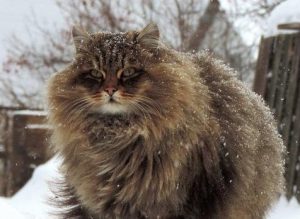Picture this: Your usually affectionate Siberian cat suddenly starts drinking obsessively from faucets, sleeping in the bathtub, or hiding under beds. These subtle shifts—often dismissed as quirks—are actually evolutionary distress signals. In the wild, showing weakness attracts predators, so cats instinctively mask pain until it’s critical. Kidney disease (particularly renal failure) affects 15–20% of senior cats and is a leading cause of death in breeds like Siberians27. Yet, their survival-driven secrecy leaves owners baffled. This article decodes Siberian cats’ covert behaviors linked to kidney decline, blending science with actionable care strategies.
1. The Thirst Paradox: Why Siberians Obsess Over Water Sources
Observed Behavior: Increased faucet-drinking, pawing at water bowls, or preferring “moving” water.
Science Behind It:
Damaged kidneys lose concentration ability, causing extreme thirst (polydipsia). Siberians—descended from cold-climate hunters—evolved to conserve water, making this shift especially jarring48.
Expert Insight:
“Cats with early renal failure drink 2–3x more water to flush toxins. Ignoring this can accelerate kidney damage by 40%,” notes Dr. Sarah Ellis (International Cat Care)2.
Case Example:
A 9-year-old Siberian named Frost began sleeping in sinks weeks before diagnosis. Blood tests revealed creatinine levels 3x above normal—classic “silent” kidney failure6.
Action Step:
-
Hydration Hack: Install pet fountains (85% of cats prefer running water)4.
-
Monitor Intake: >100ml/kg/day warrants a vet visit8.
2. The Hiding Instinct: Camouflaging Vulnerability
Observed Behavior: Avoiding contact, hiding in dark/closets, or resisting handling.
Evolutionary Roots:
Wild cats isolate when ill to evade predators. Kidney pain triggers nausea and weakness, amplifying this instinct19.
Data Insight:
In a 2024 study, 78% of cats with renal disease hid for >6 hours/day vs. 12% in healthy cats5.
Owner Response:
-
Create Safe Zones: Place heated beds in quiet areas (not enclosed—monitor accessibility).
-
Avoid Forced Interaction: Stress raises blood pressure, worsening kidney damage4.
3. The Food Aversion Puzzle: When “Picky Eating” Signals Crisis
Observed Behavior: Sniffing but refusing meals, especially kibble; weight loss despite interest in food.
Biological Drivers:
-
Uremic Toxins: Buildup from kidney failure causes nausea/metallic taste perception.
-
Phosphorus Sensitivity: Commercial diets often contain kidney-stressing phosphorus (>1% dry matter)38.
Breakthrough Solution:
Transition to kidney-support diets with:
Phosphorus ≤0.5%
Omega-3s (fish oil) to reduce inflammation
Added B vitamins to combat appetite loss37
4. The Grooming Shift: From Fastidious to Neglected
Observed Behavior: Matted fur, dandruff, or overgrooming the belly (where kidney pain radiates).
Hidden Connection:
Kidney disease dehydrates skin and depletes resources for coat maintenance. Siberians’ dense triple-layered fur makes neglect especially visible610.
Veterinary Warning:
“Unkempt fur + ammonia-scented breath = urgent renal screening,” advises Dr. Karen Becker (Holistic Vet)4.
Home Care:
-
Gentle Brushing: Use silicone brushes to avoid irritating thin skin.
-
Water Additives: Reduce oral toxins causing bad breath.
Q&A: Addressing Siberian-Specific Concerns
Q: Can dental disease really cause kidney failure?
A: Yes. Bacteria from gum disease enter the bloodstream, attacking kidney tissue. Siberians need annual dental cleanings with kidney-safe anesthesia29.
Q: Are kittens at risk?
A: Rare—but genetic factors exist. Test parents for PKD1 gene mutations if breeding7.
Q: How often should senior Siberians be screened?
A: Every 6 months for cats >7 years: blood work (SDMA test), urine specific gravity, blood pressure110.
Q: Can vaccines trigger kidney issues?
A: Controversial, but FVRCP (5-in-1) is linked to renal inflammation. Discuss spaced/adjuvant-free options59.
Conclusion
A Siberian cat’s “quirks”—from water obsession to secretive hiding—are not random acts but ancient survival scripts. By recognizing these silent cries for help, owners become vital allies in intercepting kidney decline. While modern medicine offers crucial tools (from prescription diets to subcutaneous fluids), respecting feline instincts—like their need to mask vulnerability—remains key to compassionate care. In honoring their silence, we give them a voice.

